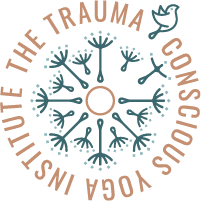 Trauma-Conscious yoga, trauma-focused yoga, trauma-sensitive yoga, and trauma-informed yoga are all terms you will see used interchangeably to relate to a shared experience- a yogic space that considers the impacts trauma has on a person’s brain & nervous system, mind, body, spirit, heart and ability to cope in this world; a yogic space that consciously and devotedly creates an environment most supportive of helping traumatized people resolve their trauma and heal themselves inside and out.
Trauma-Conscious yoga, trauma-focused yoga, trauma-sensitive yoga, and trauma-informed yoga are all terms you will see used interchangeably to relate to a shared experience- a yogic space that considers the impacts trauma has on a person’s brain & nervous system, mind, body, spirit, heart and ability to cope in this world; a yogic space that consciously and devotedly creates an environment most supportive of helping traumatized people resolve their trauma and heal themselves inside and out.
Though trauma-conscious yoga is becoming increasingly popular and talked about, it’s formal conception is relatively new. Before we look at the history of standardized trauma-conscious yoga in the U.S., let’s go back to the country of yoga’s roots.
Yoga in India:
In The Trauma-Conscious Yoga Method℠ Teacher Training we review, in-depth, the ways in which today’s yoga in the U.S. is both dissimilar and similar to yoga in the East, as well as how and why these differences have come about. For the purposes of this article we will not venture as thoroughly into that topic, but we will cover a bit of this here now. The goal of yoga, in its origins, was not stress reduction or trauma resolution, although this may have been an inherent benefit to a dedicated practice. The practice of yoga in India began as one between guru and disciple with the intention of gaining liberation from the Ego and re-connection to one’s divinity, or true Self. This is not to say that some yoga pioneers were not concerned with trauma or considerate of the ways in which yoga can support emotional well-being, but the practice of yoga was characterized by spiritual intentions.
The terms “trauma-conscious yoga,” “trauma-focused yoga,” “trauma-sensitive yoga,” and “trauma-informed yoga” are the creations and adaptations of Westerners. These terms have become popularized in the U.S. but are not terms commonly used in traditional yogic circles in the East.
How do we identify the inception of Trauma-Conscious Yoga?
This is challenging because while there is a time that we can pinpoint when the teachings and terms became popularized and supported by research, I do not think we can identify exactly when these teachings began.
I would like to think that all throughout the history of yoga there have been skilled and intuitive yoga teachers who have devoted themselves to working with trauma survivors, and that through experience, & trial and error, these teachers have adapted their teachings to support the traumatized villages/people with whom they’ve worked. I am personally curious about the ways in which race, power and privilege have impacted the very ways in which trauma-conscious yoga has become a recognized term and formalized approach.
The more formal conception of Trauma-Conscious Yoga:
In 2002, a yoga teacher named David Emerson, dedicated to working with people who had experienced trauma, approached Bessel van der Kolk (psychiatrist, trauma pioneer and author of The Body Keeps the Score) to inquire about a partnership to explore further the idea of yoga as a treatment for trauma recovery.
Together the two organized the first pilot study in 2003 under the Trauma Center at the Justice Resource Institute in Brookline, Massachusetts. Additional staff were brought on to support supplementary pilot studies to take place thereafter. Through this dedicated research, yoga was proven to be an effective modality to support trauma recovery and resolution of PTSD symptoms.
Trauma-conscious yoga, now supported by research and evidence-based, began to grow, evolve and receive increased interest and popularity. Trauma-conscious yoga teacher trainings were cultivated by David Emerson’s group and others.
In large part it is due to this research that we now see yoga so widely accepted in clinical and alternative settings (i.e. drug/alcohol rehabilitation centers, prisons/jails, Mental Health clinics, hospitals, etc).
The history of The Trauma-Conscious Yoga Method℠:
In 2014, upon having a casual conversation one day with my friend and yoga colleague Julie Dohrman, I got talking about the integrative trauma work that I do as both yoga and mental health professional and she asked me to come lead a five-hour trauma-informed yoga lecture within her 200-hour yoga teacher training. I led that lecture in Brooklyn, NY and not only did Julie’s trainees attend, but many yoga teachers and mental health professionals from the community did as well. The community was thirsting for this information and that enlivened me. I observed that in five hours I was able to cover the basics, but could not go super deep, and there is A LOT to learn in relation to trauma! And as a clinician myself, I felt I wasn’t doing enough of a service to simply teach the mental health professionals the approach while providing no information about how to integrate yoga into their clinical work.
I returned to my new home in Austin, TX and decided I would create something larger and more in-depth; a trauma-conscious yoga training with clinical awareness and a consciousness toward the needs of not only yoga professionals, but also mental health clinicians who had not completed a formal yoga teacher training. Enter, The Trauma-Conscious Yoga Method℠: a modality inspired from the heart and by my life’s work as both yoga and mental health professional. A modality that integrates trauma-informed yoga with somatic psychotherapy practices in an effort to support clients in empowerment, embodiment, and evolution in their paths to trauma healing.
Thank you for being a part of this vision and Sangha (community). Thank you for making your mark on the world.
The Trauma-Conscious Yoga Method℠ Copyright © *|2018|* *The Trauma-Conscious Yoga Institute℠ & Nityda Gessel, LCSW , E-RYT, TIYT*, All rights reserved.

